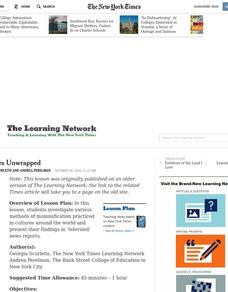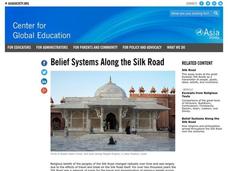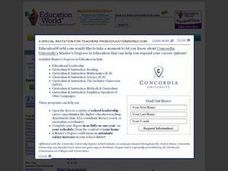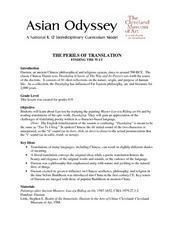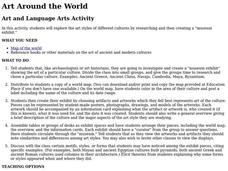Curated OER
Dude, Where's My Karma?
Students research various aspects of Indian culture. They create a Book of Knowledge about India. In a second activity they research the history behind any game. They make presentations and play the different games during Game Day.
Curated OER
Mummies Unwrapped
Students investigate various methods of mummification practiced in cultures around the world and present their findings in 'televised' news reports.
Curated OER
Belief Systems Along the Silk Roads
Students reflect on similarities and differences among belief systems. Using excerpts of translated religious texts, they organize these quotations into broad themes. The quotations will be posted on a Silk Roads map as reminders of how...
Curated OER
Location of Cities 201
Students work in pairs to locate the ancient cities on a world atlas using the longitude and latitude measurements. They examine the physical and human futures that explain their locations.
Curated OER
The Daoist Immortals
Students discover the basic principles and beliefs of Daoism through investigation and in-class discussion in this High School lesson for a Social Studies, Humanities, or Asian Studies class.
Curated OER
Stolen Property or Finders Keepers
Young scholars explore the questionable acquisition of priceless artworks gained as spoils of World War II. They become investigators and reporters looking into the matter of ownership of the world's greatest art.
Curated OER
Make A Mummy: The Science of Mummification
Students research the history of mummification. They work together to create an apple mummy. They write a paragraph about what they gathered while doing the experiment.
Curated OER
The Perils of Translation
Students discover the challenges of translating poetry written in a character-based language through the study of Lao-tzu's work, Daodejing. This lesson includes possible extensions and evaluations.
Curated OER
Yin And Yang
Students examine the symbols of change, Heaven and Earth, as expressed in
Chinese art and literature in this High School lesson. Evaluation is accomplished through a short, small-group research project.
Curated OER
Silk: Scientific Inquiry Through Chinese Art
Students investigate the many uses of silk in Chinese society through in-class experiments, group projects, and hands-on learning in this cross-curricular lesson. There are four main activities included in this lesson.
Curated OER
Haiku and Beyond: Exploring Genres of Japanese Literature
Fourth graders compare and contrast the literature of Japan as they study the culture, history and geography of the island nation. They read various genres of literature, describe geographic and landform features of Japan, and find...
Curated OER
A Lucky Break
Students complete activities where they identify and decipher common phrases that are related to poultry and then cook drumsticks as a class. In this poultry lesson plan, students also read the history of the chicken and create idioms.
Curated OER
Activating Students Through Storytelling
Fourth graders produce a podcast of a elements of a Chinese folk tale. In this Chinese folk tale and podcasting lesson plan, 4th graders watch as the teacher performs Peach Blossom Spring: A Chinese folk tale. They decide on who will...
Curated OER
Colossal Structures and Sculptures
Students discuss the connection between culture and art and why people create art. Students discuss Mt. Rushmore, The Sphinx, the goddess Athena, Roman columns, The Great Wall of China, The Buddha, and use tools and techniques to create ...
Curated OER
Comparisons: Geography
In this geography comparisons instructional activity, students read seven short descriptions of interesting places in the world. Using the ten words in the word bank, students fill in the blanks in the sentences.
Curated OER
Art Around the World
Eleventh graders explore the art styles of different cultures by researching and then creating a "museum exhibit".
Curated OER
Religion And Magic
Students examine the indigenous religions of China (Daoism) and Japan (Shinto) to see how magical beliefs and practices form an integral part of these religions. This lesson may be controversial.
Curated OER
The Rulers of Sky And Earth
Students investigate how symbols of power, the dragon and the tiger, are portrayed in the art of China and Japan and compare and contrast this with the Western conception and portrayal of the dragon.
Curated OER
Treasure of the Silk Roads
Students generate world maps that act as creative writing prompts. The prompts reflect on the cultures and history of the past through their own experiences. Students create an original writing sample.
Curated OER
The Chinese Produce Paper as We Know it Today
Tenth graders explore where paper originated and its importance from the Chinese to the rest of the world. They list ten ways that they use paper on a daily basis and rate that use on a scale from one to ten. Each group also brainstorms...
American Museum of Natural History
Make Your Own Paper
Paper, paper everywhere. Paper is so prolific that few think about where the idea for it originated and how it is made. Introduce young readers to the paper-making process with an activity that lets them create their own.
Curated OER
Hindu Gods Batik
Students identify the major Hindu gods and describe the relationship between them. They examine symbols and determine their meanings. They create a batik of a Hindu god of their choice and research them.
Curated OER
The Peanut Wizard
Students read and discuss information regarding George Washington Carver and how the peanut became cultivated in the southern colonies of the United States. In this George Washington Carver lesson, students develop vocabulary that...
Curated OER
Chinese Dynasties
Pupils explore several Chinese dynasties and research various topics including papermaking, calligraphy, and Lu Hou. They also demonstrate how to use an abacus and create several math problems to solve with it. Choosing a dynasty,...



